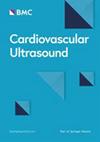健康幼年兰德瑞斯猪的心脏尺寸和血液动力学特征
IF 1.6
3区 医学
Q3 CARDIAC & CARDIOVASCULAR SYSTEMS
引用次数: 0
摘要
猪经常被用作心血管研究的动物模型,特别是在代表人体解剖学和生理学方面。研究中最常用物种的参考值对于动物试验的计划和执行非常重要。经食道超声心动图是术中成像的黄金标准,但在猪身上具有技术挑战性。其前身心外膜超声心动图(EE)是一种简单快捷的术中成像技术,可进行全面和目标明确的评估。然而,描述幼年猪超声心动图参数的研究很少,其中没有一项使用 EE。因此,在本研究中,我们使用 EE 提供了猪多种几何和功能超声心动图参数以及基本血流动力学参数的综合数据集。数据收集是在左心室辅助装置植入前对 10 头雌性猪(德国陆地猪,104.4 ± 13.0 千克)进行动物试验时进行的。在植入左心室辅助装置之前和期间,连续记录了血液动力学数据。本文所述的超声心动图测量均按照标准化方案进行,包括心尖、左室短轴、长轴和主动脉上窗。总共评估了 50 项超声心动图参数和 10 项血液动力学参数。所有动物都成功进行了心外膜超声心动图检查,检查时间中位数为 14 分钟(四分位间范围为 11-18 分钟)。在左心室功能方面,采用 Teichholz 法和 Simpson 法计算的射血分数分别为 51.6 ± 5.9% 和 51.2 ± 6.2%。计算得出的心室质量为 301.1 ± 64.0 克,左心室收缩末和舒张末直径分别为 35.3 ± 2.5 毫米和 48.2 ± 3.5 毫米。平均心率为 103 ± 28 bpm,平均动脉压为 101 ± 20 mmHg,颈总动脉平均流量为 627 ± 203 mL/min。心外膜超声心动图可全面评估大多数常见的超声心动图参数。与人类相比,猪在心室质量、大小和室壁厚度方面存在很大差异,尤其是右心。大多数血液动力学参数在猪和人之间具有可比性。这些数据为研究规划、动物和设备选择提供了支持,强化了动物研究中的三R原则。本文章由计算机程序翻译,如有差异,请以英文原文为准。
Cardiac dimensions and hemodynamics in healthy juvenile Landrace swine
Swine are frequently used as animal model for cardiovascular research, especially in terms of representativity of human anatomy and physiology. Reference values for the most common species used in research are important for planning and execution of animal testing. Transesophageal echocardiography is the gold standard for intraoperative imaging, but can be technically challenging in swine. Its predecessor, epicardial echocardiography (EE), is a simple and fast intraoperative imaging technique, which allows comprehensive and goal-directed assessment. However, there are few echocardiographic studies describing echocardiographic parameters in juvenile swine, none of them using EE. Therefore, in this study, we provide a comprehensive dataset on multiple geometric and functional echocardiographic parameters, as well as basic hemodynamic parameters in swine using EE. The data collection was performed during animal testing in ten female swine (German Landrace, 104.4 ± 13.0 kg) before left ventricular assist device implantation. Hemodynamic data was recorded continuously, before and during EE. The herein described echocardiographic measurements were acquired according to a standardized protocol, encompassing apical, left ventricular short axis and long axis as well as epiaortic windows. In total, 50 echocardiographic parameters and 10 hemodynamic parameters were assessed. Epicardial echocardiography was successfully performed in all animals, with a median screening time of 14 min (interquartile range 11–18 min). Referring to left ventricular function, ejection fraction was 51.6 ± 5.9% and 51.2 ± 6.2% using the Teichholz and Simpson methods, respectively. Calculated ventricular mass was 301.1 ± 64.0 g, as the left ventricular end-systolic and end-diastolic diameters were 35.3 ± 2.5 mm and 48.2 ± 3.5 mm, respectively. The mean heart rate was 103 ± 28 bpm, mean arterial pressure was 101 ± 20 mmHg and mean flow at the common carotid artery was 627 ± 203 mL/min. Epicardial echocardiography allows comprehensive assessment of most common echocardiographic parameters. Compared to humans, there are important differences in swine with respect to ventricular mass, size and wall thickness, especially in the right heart. Most hemodynamic parameters were comparable between swine and humans. This data supports study planning, animal and device selection, reinforcing the three R principles in animal research.
求助全文
通过发布文献求助,成功后即可免费获取论文全文。
去求助
来源期刊

Cardiovascular Ultrasound
CARDIAC & CARDIOVASCULAR SYSTEMS-
CiteScore
4.10
自引率
0.00%
发文量
28
审稿时长
>12 weeks
期刊介绍:
Cardiovascular Ultrasound is an online journal, publishing peer-reviewed: original research; authoritative reviews; case reports on challenging and/or unusual diagnostic aspects; and expert opinions on new techniques and technologies. We are particularly interested in articles that include relevant images or video files, which provide an additional dimension to published articles and enhance understanding.
As an open access journal, Cardiovascular Ultrasound ensures high visibility for authors in addition to providing an up-to-date and freely available resource for the community. The journal welcomes discussion, and provides a forum for publishing opinion and debate ranging from biology to engineering to clinical echocardiography, with both speed and versatility.
 求助内容:
求助内容: 应助结果提醒方式:
应助结果提醒方式:


